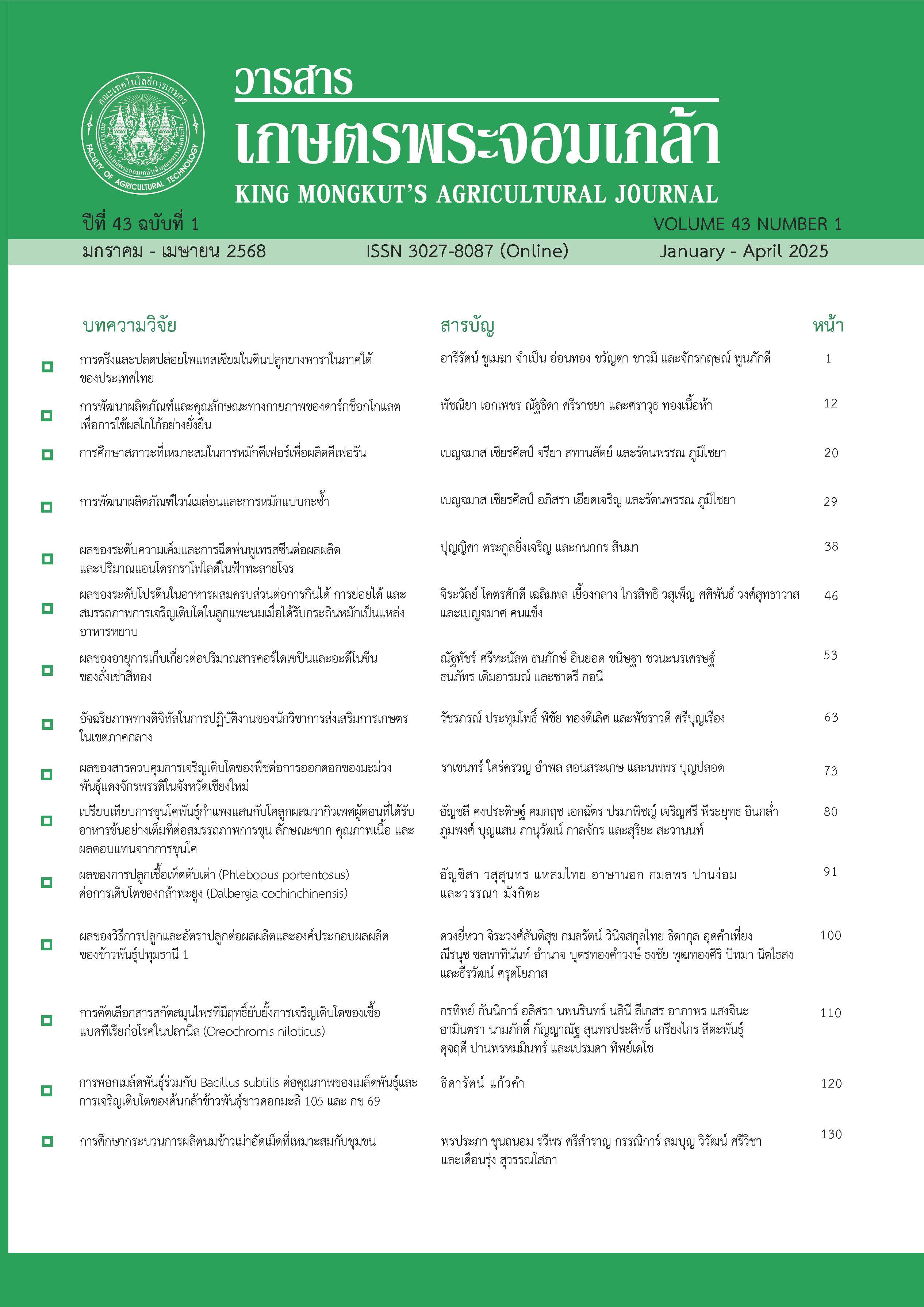ผลของระดับความเค็มและการฉีดพ่นพูเทรสซีนต่อผลผลิตและปริมาณแอนโดรกราโฟไลด์ในฟ้าทะลายโจร
Main Article Content
บทคัดย่อ
ความเค็มของดินนับเป็นปัจจัยแวดล้อมที่สำคัญมากในการจำกัดผลผลิตและปริมาณสารสำคัญของพืชหลายชนิด สารพูเทรสซีนเป็นสารอินทรีย์ที่ประกอบด้วยหมู่อะมิโน 2 หมู่ มีบทบาทสำคัญในการควบคุมกระบวนการต่าง ๆ ที่เกี่ยวข้องกับการเจริญเติบโตและการลดความเครียดของพืชหลายชนิด งานวิจัยจึงศึกษาถึงผลของการฉีดพ่นสารพูเทรสซีนในฟ้าทะลายโจรที่ได้รับความเครียดจากความเค็มระดับต่างๆ ออกแบบการทดลองเป็นแบบสุ่มสมบูรณ์โดยจัดการทดลองแบบแฟคทอเรียล (Factorial in CRD) จำนวน 5 ซ้ำ 2 ปัจจัย ในดินชุดกำแพงแสน กำหนดปัจจัย A เป็นระดับความเค็ม ได้แก่ 0, 5 และ 10 เดซิซีเมนส์/เมตร และปัจจัย B คือความเข้มข้นของสารพูเทรสซีนที่ใช้ฉีดพ่นทางใบ ได้แก่ 0, 150 และ 300 พีพีเอ็ม ทำการเก็บเกี่ยวหลังปลูกฟ้าทะลายโจรได้ 120 วัน และบันทึกน้ำหนักสดและน้ำหนักแห้งของส่วนเหนือดิน ปริมาณไฮโดรเจนเปอร์ออกไซด์ (H2O2) และสารแอนโดรกราโฟไลด์ ผลการทดลองพบว่าระดับความเค็มส่งผลให้ฟ้าทะลายโจรมีน้ำหนักสดและน้ำหนักแห้งลดลงแต่ปริมาณ H2O2 เพิ่มขึ้นอย่างมีนัยสำคัญ และเมื่อได้รับการฉีดพ่นพูเทรสซีนทำให้น้ำหนักเพิ่มขึ้นและ H2O2 ลดลงอย่างมีนัยสำคัญเมื่อเทียบกับฟ้าทะลายโจรที่ไม่ได้รับการฉีดพ่นสารพูเทรสซีน นอกจากนี้ยังพบว่าความเค็มทำให้ปริมาณสารแอนโดรกราโฟไลด์สะสมมากในฟ้าทะลายโจร เมื่อฉีดพ่นสารพูเทรสซีนที่ระดับความเข้มข้น 150 พีพีเอ็ม ทำให้ปริมาณสารแอนโดรกราโฟไลด์ต่อหน่วยน้ำหนักและปริมาณสารแอนโดรกราโฟไลด์ทั้งต้นสะสมสูงที่สุดอย่างมีนัยสำคัญ ที่ระดับ 80.7 และ 307.1 มิลลิกรัม/กรัม ตามลำดับ
Article Details

อนุญาตภายใต้เงื่อนไข Creative Commons Attribution-NonCommercial-NoDerivatives 4.0 International License.
วารสารเกษตรพระจอมเกล้า
เอกสารอ้างอิง
Elbar, O. A., Farag, R. E., & Shehata, S. A. (2019). Effect of putrescine application on some growth, biochemical and anatomical characteristics of Thymus vulgaris L. under drought stress. Annals of Agricultural Sciences, 64(2), 129-137. https://doi.org/10.1016/j.aoas.2019.10.001
Ben-Asher, J., Tsuyuki, I., Bravdo, B.-A., & Sagih, M. (2006). Irrigation of grapevines with saline water: I. Leaf area index, stomatal conductance, transpiration and photosynthesis. Agricultural Water Management, 83(1), 13-21. https://doi.org/10.1016/j.agwat.2006.01.002
Chuenim, N., Boonsuk, S., & Poopaibool, P. (2006). The determination of total lactone contents in andrographis herb from various locations. In Proceedings of the 44th Kasetsart University, pp. 534-538. Kasetsart University. (in Thai).
Ghalati, R. E., Shamili, M., & Homaei, A. (2020). Effect of putrescine on biochemical and physiological characteristics of guava (Psidium guajava L.) seedlings under salt stress. Scientia Horticulturae, 261(1), 108961. https://doi.org/10.1016/j.scienta.2019.108961
Department of Thai Traditional and Alternative Medicine. (2022). Precaution about Using “Andrographolide” in the Product "Fah Talai Joan" for "Treatment of COVID-19. Beyond Publishing Ltd. (in Thai).
Gill, S. S., & Tuteja, N. (2010). Polyamines and abiotic stress tolerance in plants. Plant Signaling Behavior, 5(1), 26-33. https://doi:10.4161/psb.5.1.10291
Islam, M. J., Ryu, B. R., Azad, M. O. K., Rahman, M. H., Rana, M. S., Lim, J. D., & Lim, Y. S. (2021). Exogenous putrescine enhances salt tolerance and ginsenosides content in Korean ginseng (Panax ginseng Meyer) sprouts. Plants, 10(7), 1313. https://doi.org/10.3390/plants10071313
Kumar, J., Singh, S., Singh, M., Srivastava, P. K., Mishra, R. K., Singh, V. P., & Prasad, S. M. (2017). Transcriptional regulation of salinity stress in plants: A short review. Plant Gene, 11(1), 160-169. https://doi.org/10.1016/j.plgene.2017.04.001
Ma, S., Zhou, X., Jahan, M. S., Guo, S., Tian, M., Zhou, R., & Shu, S. (2022). Putrescine regulates stomatal opening of cucumber leaves under salt stress via the H2O2-mediated signaling pathway. Plant Physiology and Biochemistry, 170(1), 87-97. https://doi.org/10.1016/j.plaphy.2021.11.028
National Drug System Development Committee. (2021). Thai Government Gazette 138. Retrieved from: http://dmsic.moph.go.th/index/download/852 (in Thai).
Osotsapa, Y. (2017). Plant stress and alleviate. Thai Journal of Soils and Fertilizers, 38(1), 47-78. (in Thai).
Pholphana, N., Rangkadilok, N., Saehun, J., Ritruechai, S., & Satayavivad, J. (2013). Changes in the contents of four active diterpenoids at different growth stages in Andrographis paniculata (Burm.f.) Nees (Chuanxinlian). Chin Med, 8(1), 2. https://doi:10.1186/1749-8546-8-2
Rajpar, I., Khanif Y. M., & Saad, M. S. (2007). Salt tolerance in Andrographis Paniculata accessions. Society for Southeast Asian Agricultural Sciences, 13(1), 1-9.
Rajpar, I., Yusop, M. K, Ul-hassan, Z., Shah, A. N. Arshad, M., & Galani, S. (2011). Growth, herb yield and phytochemical contents in a medicinal herb Andrographis paniculata under saline irrigation. Journal of Medicinal Plants Research, 5(23), 5528-33
Suleiman, S., Wilson, C., & Grieve, C. M. (2002). Effect of salinity and exogenously applied polyamines on growth and ion relations in spinach. Journal of Plant Nutrition, 25(12), 2705-2717. https://doi:10.1081/PLN-120015533
Talei, D., Valdiani, A., Maziah, M., Sagineedu, S. R., & Saad, M. S. (2013). Analysis of the anticancer phytochemicals in Andrographis paniculata Nees. under salinity stress. BioMed Research International, 2013(1), 319047. https://doi:10.1155/2013/319047
Tang, W., & Newton, R. J. (2005). Polyamines reduce salt-induced oxidative damage by increasing the activities of antioxidant enzymes and decreasing lipid peroxidation in Virginia Pine. Plant Growth Regulation, 46(1), 31-43. https://doi:10.1007/s10725-005-6395-0.
Tian, Y., Wang, Q., Zhang, L., Kang, G., Yang, L., Hao, H., & Cong, P. (2009). Promotion effect of exogenous putrescine on anthocyanin accumulation in ‘Red Fuji’. Apple Fruits, 44(03), 310-316. https://doi:10.3969/j.issn.1674-3466.2009.03.007
Velikova, V., Yordanov, I., & Edreva, A. (2000). Oxidative stress and some antioxidant systems in acid rain-treated bean plants: protective role of exogenous polyamines. Plant Science, 151(1), 59-66. https://doi.org/10.1016/S0168-9452(99)00197-1
Verma, S., & Mishra, S. N. (2005). Putrescine alleviation of growth in salt stressed Brassica juncea by inducing antioxidative defense system. Journal of Plant Physiology, 162(6), 669-677. https://doi.org/10.1016/j.jplph.2004.08.008
Wongkittipong, R., Prat, L., Damronglerd, S., & Gourdon, C. (2004). Solid–liquid extraction of andrographolide from plants—experimental study, kinetic reaction and model. Separation and Purification Technology, 40(2), 147-154. https://doi.org/10.1016/j.seppur.2004.02.002
Zapata, P. J., Serrano, M. a., Pretel, M. T., Amorós, A., & Botella, M. Á. (2004). Polyamines and ethylene changes during germination of different plant species under salinity. Plant Science, 167(4), 781-788. https://doi.org/10.1016/j.plantsci.2004.05.014


